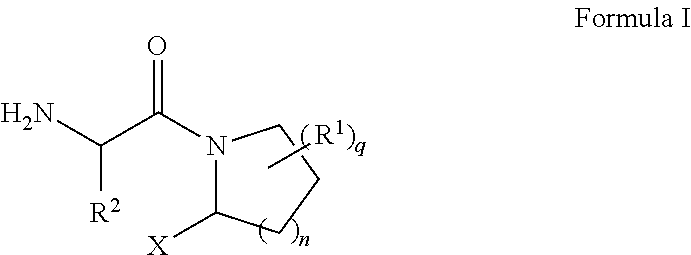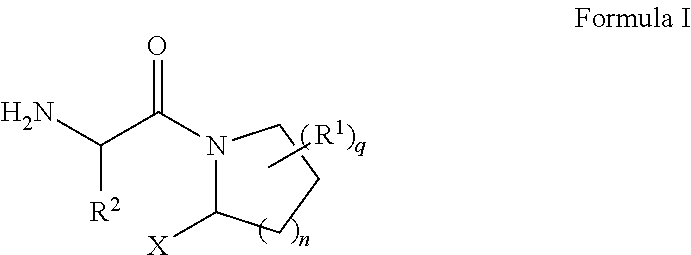Small Molecule Enhancer for Dendritic Cell Cancer Vaccines
a dendritic cell and enhancer technology, applied in immunology, therapy, antibody medical ingredients, etc., can solve the problems of not meeting the requirements of cancer vaccines, cancer vaccines, and other than provenge, and failed to achieve the desired effect in clinical trials
- Summary
- Abstract
- Description
- Claims
- Application Information
AI Technical Summary
Benefits of technology
Problems solved by technology
Method used
Image
Examples
example 1
Rationale, Synthesis of Compounds, and Inhibition of RMS Tumor Growth
Synthesis of ARI-4175.
[0156]Commercially available L-boroPro-pn 2 was coupled to an N-Boc protected unnatural amino acid Boc-Tle-OH 3 (CAS NO 62965-35-9) using HATU to render a protected dipeptide boronate Boc-Tle-boroPro-pn. Concurrent removal of both protection groups by trichloroborane (BCl3) followed by reverse-phase HPLC purification yields the desired product 1 (ARI-4175) as an HCl salt.
Synthesis of PT-100.
[0157]PT-100 was synthesized as previously described in sufficient quantities for the studies described in the following examples.
[0158]ARI-4175 is a nanomolar inhibitor of the DPP-IV-like serine proteases, including DPPs 8 and 9 (Table 1), which are the putative targets in PT-100's immune mechanism of action. Inhibition of DPP-IV and FAP activity may also contribute to the antitumor effect of PT-100 because selective abrogation of DPP-IV or FAP activity appears to slow tumor growth.
TABLE 1Potency of inhibi...
example 2
Effectiveness of ARI-4175 in the RMS DC Tumor Vaccine Model
[0161]FIG. 17 A shows the experimental setup for priming of T cell donors and T cell recipients. FIG. 17 B shows the tumor volume curve (mean±standard deviation) and survival curve. Mice receiving ARI-4175 alone had significantly smaller tumors compared to saline (n=10, p=0.0019). Though ARI-4175+primed T cell recipients had smaller tumors, the difference was not significant when compared to ARI-4175+naïve T cell recipients (n=10, p=0.0755). Eight of ten ARI-4175+primed T cell recipients survived to day 80, however this was not significant compared to the 40% survival of ARI-4175+naïve T cell recipients (n=10, p=0.0658).
[0162]FIGS. 18 A and B show that combination treatment with ARI-4175 and adoptive T cell transfer in Rag1− / − recipients significantly reduces RMS M3-9-M volume. (A) Female Rag1− / − mice received naïve or RMS-primed T cells one day after tumor challenge. (B) By day 10, ARI-4175 treated mice had significantly sm...
example 3
Induction of IL-1β and Upregulation of Cytokine and Chemokine Expression in Tumors and Draining Lymph Nodes by Ala-boroPro (2243), Val-boroPro (PT-100, 2054), and t-BuGly-boroPro (ARI-4175)
[0165]Method for Cytokine Assay in BALB / c Mice.
[0166]Female BALB / c mice were treated with various doses of PT-100 or ARI-4175 by oral gavage (PO) or intraperitoneal (IP) injection and serum was analyzed for chemokines (FIGS. 4, 5, and 6). Blood was collected by cardiac puncture at various times post-dose and serum was prepared for analysis by ELISA. The samples were assayed for mouse cytokines G-CSF and mouse CXCL1 using ELISA kits from R&D Systems (Cat. No. MCS00 and MKC00B respectively). All measurements were made in duplicate. Serum samples were diluted as necessary to obtain values within the range of the assays. Optimal dilutions required varied depending on the test agent and can range from no dilution for control samples or test agents with no activity to 1:1000 dilution for very high sampl...
PUM
| Property | Measurement | Unit |
|---|---|---|
| pH | aaaaa | aaaaa |
| pH | aaaaa | aaaaa |
| hydrophobic | aaaaa | aaaaa |
Abstract
Description
Claims
Application Information
 Login to View More
Login to View More - R&D
- Intellectual Property
- Life Sciences
- Materials
- Tech Scout
- Unparalleled Data Quality
- Higher Quality Content
- 60% Fewer Hallucinations
Browse by: Latest US Patents, China's latest patents, Technical Efficacy Thesaurus, Application Domain, Technology Topic, Popular Technical Reports.
© 2025 PatSnap. All rights reserved.Legal|Privacy policy|Modern Slavery Act Transparency Statement|Sitemap|About US| Contact US: help@patsnap.com



